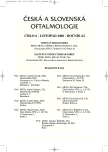Epidemiology of the Endocrine Orbitopathy
Authors:
J. Čmelo 1; M. Chynoranský 2; J. Podoba 3; Z. Benejová 4; J. Blašková 1; S. Ferková 2; B. Farkašová 1; I. Kalafutová 4; K. Kramplová 1; A. Lacková 4; D. Malacká 4; K. Mičevová 1; S. Oláhová 1; E. Petráková 1; M. Podobová 4; D. Prokešová 4; M. Rybár 4; S. Ružináková 4; A. Smorádková 1; J. Štekláč 3; T. Valášková 1; I. Veres 4
Authors‘ workplace:
Neštátna očná ambulancia, Bratislava, Považská Bystrica, Štúrovo
1; Klinika oftalmológie LF UK, Bratislava
prednosta prof. MUDr. Peter Strmeň, CSc.
2; Katedra endokrinológie SZU, Bratislava
vedúci doc. MUDr. J. Podoba CSc.
3; Endokrinologická ambulancia, Bratislava.
4
Published in:
Čes. a slov. Oftal., 62, 2006, No. 6, p. 373-380
Overview
The goal of this paper was to evaluate epidemiological data of the endocrine orbitopathy in a group of 126 patients (250 eyes) during the 5-years period (1999–2004). The prevalence of endocrine orbitopathy was at the age 46.5 ± 11.4 years, predominantly in females: 5.3 times more often than in males. In most cases (94 %) and independently on the sex, hyperthyroidism accompanied the endocrine orbitopathy. Hyperthyroidism mostly (91 %) preceded the appearance of the endocrine orbitopathy. Most patients with endocrine orbitopathy had eyelid signs (91 % females and 85 % males respectively), protrusion or exophtalmos (77 % females, 75 % males). 69% patients (68 % females, 70 % males) had elevated intraocular pressure (pseudoglaucoma, primary glaucoma). During the active stage of the endocrine orbitopathy with protrusion (52 % patients), pseudoglaucoma was detected in 7 % of patients. During the inactive stage of the endocrine orbitopathy with protrusion (34 % patients), pseudoglaucoma was detected in 4 % of patients. Primary glaucoma was found in 2 % (active stage) and 1 % (inactive astage).
Key words:
endocrine orbitopathy, epidemiological data, protrusion, intraocular pressure, pseudoglaucoma.
Labels
OphthalmologyArticle was published in
Czech and Slovak Ophthalmology

2006 Issue 6
Most read in this issue
- Chronic Postoperative Endophthalmitis
- Dry Eye Syndrome in Patients with Conjunctival Concretions
- Epidemiology of the Endocrine Orbitopathy
- Long-term Functional Effect of Pars Plana Virtrectomy in Complications of Prolipherative Diabetic Retinopathy
